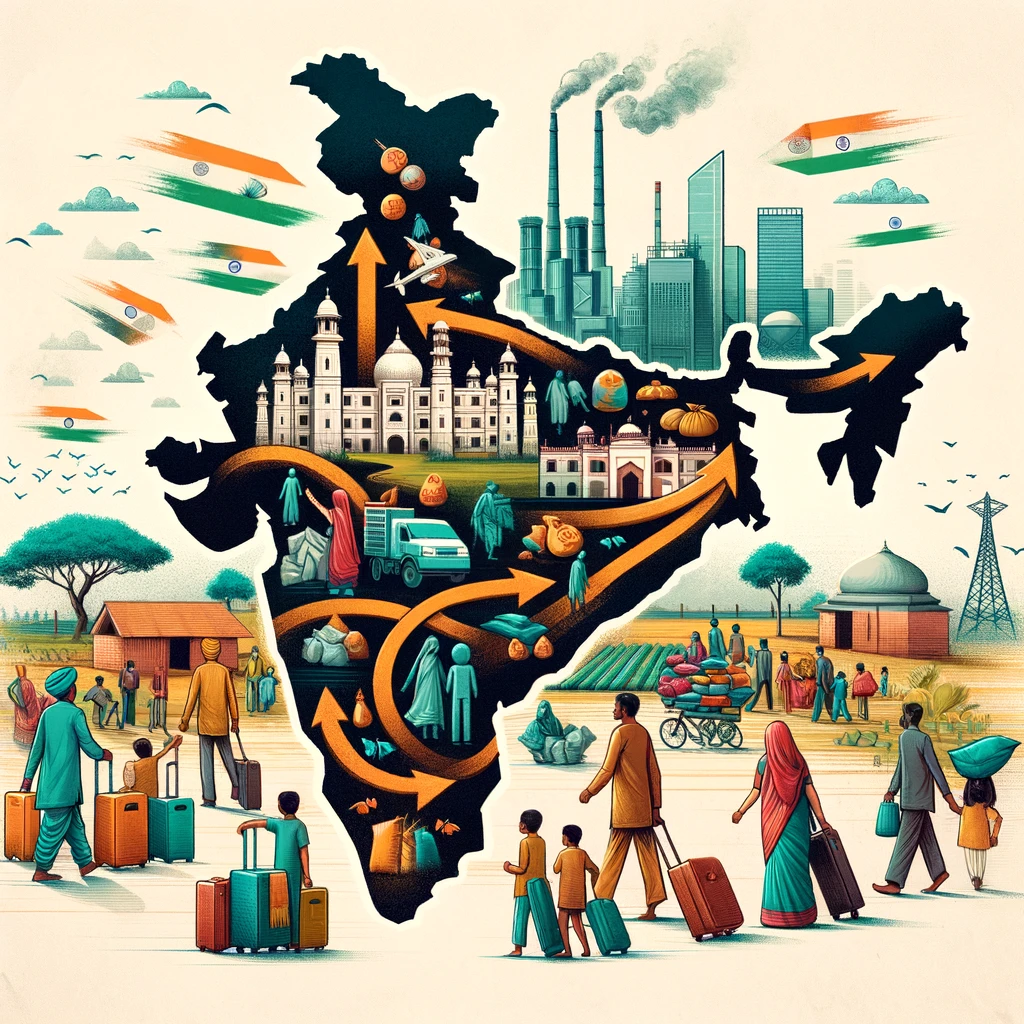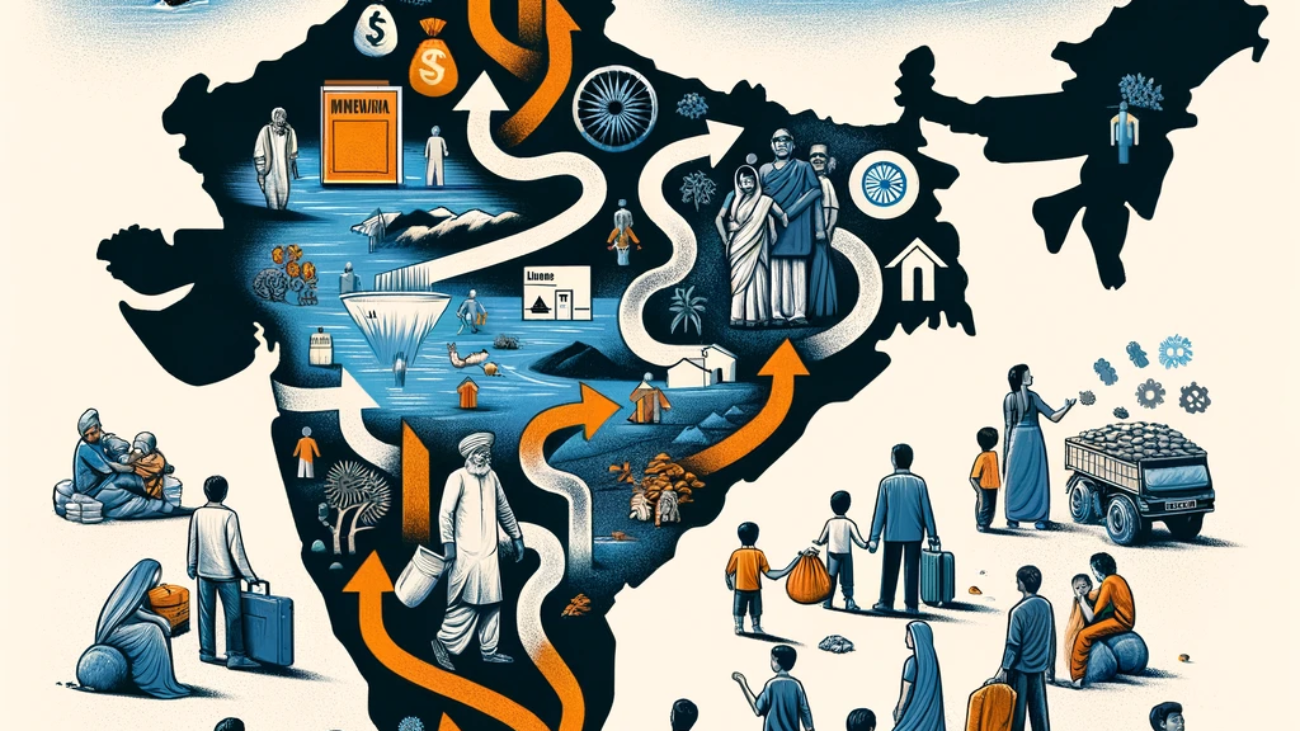Migration within India is a complex and multifaceted phenomenon, driven by a myriad of economic, social, and environmental factors. Economic disparities between regions serve as a primary driver, with less developed states like Bihar and Uttar Pradesh experiencing high net out-migration, while developed regions such as Delhi, Maharashtra, and Karnataka attract large numbers of migrants seeking better employment opportunities and living conditions. This economic pull is reinforced by the growth of service and industrial sectors in urban areas, improved educational opportunities, and enhanced transport and communication infrastructure. Conversely, factors such as poverty, environmental degradation, and shrinking rural livelihood options push individuals to leave their homes in search of better prospects.
The movement of people across states has profound implications for both the source and destination regions. In source regions, out-migration can lead to a reduction in labor supply, impacting local economies and communities. However, remittances sent back by migrants can significantly bolster the financial stability of their families and contribute to local development. In destination regions, migrants fill essential gaps in the labor market, driving economic growth and enhancing the diversity and cultural richness of urban areas. However, this influx can also strain urban infrastructure and services, creating challenges in housing, healthcare, and social integration.
This article delves into the key insights derived from various reports and statistics on inter-state migration, highlighting its significance, emerging patterns, and the challenges faced by migrants. Despite the positive impacts of migration, migrants often encounter significant challenges, including social exclusion, lack of access to political rights, and limited access to social benefits. To address these issues, the Indian government has implemented several measures, such as the Code on Social Security and the One Nation-One Ration Card scheme, aimed at providing better support and integration for migrants. Understanding these dynamics is crucial for formulating policies that promote inclusive and sustainable growth in both source and destination regions.
Migration Patterns and Economic Drivers
According to the 2011 Census, India had 45.36 crore internal migrants, accounting for 37% of the country’s population. These migrants include both inter-state and intra-state movers. The Working Group on Migration (2017) identified 17 districts, primarily in Uttar Pradesh, Bihar, and Odisha, as major sources of male out-migration. In contrast, more developed states like Delhi, Maharashtra, and Karnataka have become major hubs for migrants seeking better economic opportunities.
The Economic Survey 2016-17 corroborates this, indicating high net out-migration from less developed states like Bihar and Uttar Pradesh, while developed regions such as Delhi and Maharashtra exhibit high net immigration. The Delhi region alone accounted for more than half of migration flows in 2015-16. This pattern underscores the role of economic development in shaping migration trends, as individuals move from economically lagging areas to more prosperous regions in search of better employment prospects and quality of life.

Push and Pull Factors Influencing Migration
The interplay of various push and pull factors significantly influences migration patterns. On the push side, factors like poverty, shrinking livelihood options in rural areas, and environmental degradation force individuals to leave their homes. On the pull side, the growing service and industrial sectors in urban areas, improved educational opportunities, and enhanced transport and communication infrastructure attract migrants.
For instance, the Migration in India Report 2020-21 highlighted that 0.7% of the population were temporary visitors during the COVID-19 pandemic, reflecting the fluidity and responsiveness of migration patterns to immediate economic and environmental stressors. These trends indicate that migration is not just a response to immediate needs but also a strategic move towards long-term betterment and stability.
Challenges and Policy Responses
Migrants often face significant challenges, including social exclusion, lack of access to political rights, and limited access to social benefits. Marginalized sections, in particular, struggle to integrate into host communities and face discrimination. The need for proof of residence for accessing welfare schemes further complicates their situation, depriving them of essential services and support.
To address these challenges, the Indian government has implemented several measures. The Code on Social Security aims to provide benefits like insurance and provident fund to inter-state migrant workers. The One Nation-One Ration Card scheme enhances food security for migrant households by allowing them to access rations from any Fair Price Shop. Additionally, NITI Aayog’s draft National Policy on Migrant Workers advocates for a rights-based approach and collective action to improve migrants’ conditions.
During the COVID-19 pandemic, specific relief measures such as the E-SHRAM Portal for creating a database of migrant workers and the Affordable Rental Housing Complexes (ARHCs) scheme were introduced to support migrants. These initiatives aim to provide a safety net and facilitate better integration of migrants into urban economies.
Navigating the Complexities of Inter-State Migration in India
Inter-state migration in India is a dynamic and multifaceted phenomenon, shaped by an intricate web of economic, social, and environmental factors. Migration plays a crucial role in addressing labor shortages, enhancing skill development, and improving the overall quality of life for many individuals. The insights from various reports underscore the significant contributions of migrants to both source and destination regions, highlighting their vital role in driving economic growth and societal development. However, the benefits of migration are often accompanied by substantial challenges, particularly for marginalized sections of the population who face social exclusion, limited political rights, and restricted access to essential services.
As India continues to develop, it is imperative to address these challenges through comprehensive and inclusive policy responses. Initiatives such as the Code on Social Security and the One Nation-One Ration Card scheme are steps in the right direction, but more needs to be done to ensure the well-being and integration of migrants. Policymakers must understand and address the nuances of migration to create a supportive environment that fosters the potential of migrants while mitigating the adverse impacts. By doing so, India can harness the full benefits of inter-state migration, promoting inclusive and sustainable growth that benefits all segments of society.


Leave A Comment